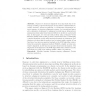113 search results - page 7 / 23 » Including Biological Literature Improves Homology Search |
ISMB
2000
13 years 8 months ago
2000
Knowing the number of residue contacts in a protein is crucial for deriving constraints useful in modeling protein folding, protein structure, and/or scoring remote homology searc...
BMCBI
2005
13 years 7 months ago
2005
Background: Biological resources are essential tools for biomedical research. Their availability is promoted through on-line catalogues. Common Access to Biological Resources and ...
NAR
2011
12 years 10 months ago
2011
We updated the plant transcription factor (TF) database to version 2.0 (PlantTFDB 2.0, http:// planttfdb.cbi.pku.edu.cn) which contains 53 319 putative TFs predicted from 49 speci...
RECOMB
2008
Springer
14 years 7 months ago
2008
Springer
Abstract. Whole genome doubling (WGD), a frequent occurrence during the evolution of the angiopsperms, complicates ancestral gene order reconstruction due to the multiplicity of so...
RECOMB
2007
Springer
14 years 7 months ago
2007
Springer
Abstract. Sequence to structure alignment is an important step in homology modeling of protein structures. Incorporation of features like secondary structure, solvent accessibility...

